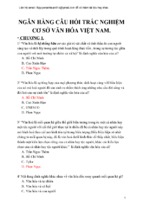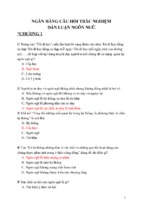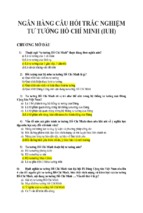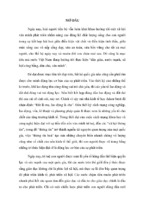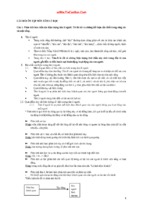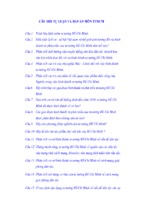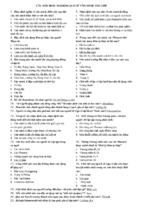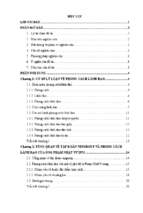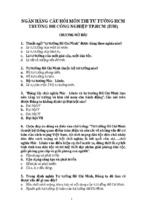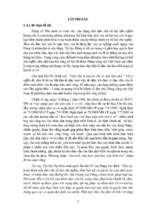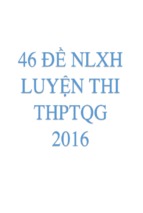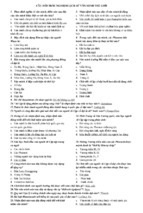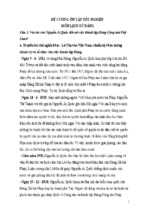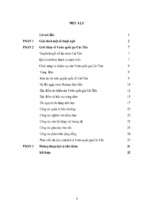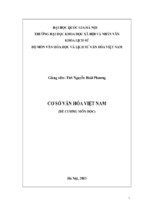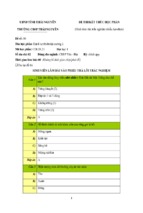MINISTRY OF EDUCATION AND TRAINING
HANOI PEDAGOGICAL UNIVERSITY 2
PHAN TRONG TIEN
β-VISCOSITY SOLUTIONS OF
HAMILTON-JACOBI EQUATIONS
AND APPLICATIONS TO
A CLASS OF OPTIMAL
CONTROL PROBLEMS
Major: Analysis
Code: 9 46 01 02
Summary of Doctoral Thesis in Mathematics
Hanoi-2020
This dissertation is completed at:
Hanoi Pedagogical University 2
Supervisor: Dr. Tran Van Bang
Assoc. Prof. Dr. Ha Tien Ngoan
First referee: . . . . . . . . . . . . . . . . . . . . . . . . . . . . . . . . . . . . . . . . . . . . . . . . . . . . .
......................................................
Second referee: . . . . . . . . . . . . . . . . . . . . . . . . . . . . . . . . . . . . . . . . . . . . . . . . . .
......................................................
Third referee: . . . . . . . . . . . . . . . . . . . . . . . . . . . . . . . . . . . . . . . . . . . . . . . . . . . .
......................................................
The thesis shall be defended at the University level Thesis Assessment Council at Hanoi Pedagogical University 2 on . . . . . . . . . . .
2019 . . . . . . . . . . . . . . . . .at . . . . . . . . . . . . . . . . .oclock . . . . . . . . . . . . . . . . ..
The dissertation is publicly available at:
- The National Library of Vietnam
- The Library of Hanoi Pedagogical University 2
INTRODUCTION
First-order Hamilton-Jacobi equations (HJEs) comprise an important class of nonlinear partial differential equations (PDEs) with
many applications. Typical examples can be found in mechanics,
optimal control theory, etc. Specifically, this class includes dynamic
programming equations arising in deterministic optimal controls,
which are known as Hamilton-Jacobi-Bellman equations. In general, these nonlinear equations do not have classical solutions. As a
result, it is necessary to study weak solutions and a viscosity solution
is such a week solution.
The theory of viscosity solutions for partial differential equations
appeared in 1980s. In particular, in the paper by M. G. Crandall
and P. L. Lions (1983), the authors introduced the viscosity solution
as a generalized solution of partial differential equations. Instead of
requiring that the solution u satisfies the given equation almost everywhere, it is sufficient for u to be a continuous functions satisfying
a pair of inequalities via sufficiently smooth test functions, or via
subdifferential and superdifferential.
The viscosity solution is an effective device to study nonlinear
Hamilton-Jacobi equations. We emphasize that a viscosity solution
is a weak solution since it is only continuous and its derivative is
defined through test functions and the extremal principle. However,
it has been proved that viscosity solution can be defined by subdifferential, superdifferential, which are called semiderivatives. It leads
to a tight connection between the theory of viscosity solution and
nonsmooth analysis which includes subdifferential theory.
Since 1993, the smooth variational principle, which was proved
by Deville, has been widely employed as an important tool to establish the uniqueness of β-viscosity solution, in the class of continuous
and bounded functions, of Hamilton-Jacobi equations of the form
u + F (Du) = f , where F is uniformly continuous on Xβ∗ and f is
uniformly continuous and bounded on X.
Optimal control problems were introduced in 1950s. It is well
known that they have many applications in Mathematics, Physics,
and application areas. By the dynamic programming principle, the
value function of an optimal control problem is a solution to an
1
associated partial differential equation. Unfortunately, since value
functions might not be differentiable, several approaches have been
introduced to study them. The viscosity solution again is an effective approach to investigate optimal control theory. To the best of
our knowledge, treating optimal control problems by viscosity solutions via subdiffrential is scared especially if the value function is
unbounded.
Recently, an increasing literature has been devoted to to the
study of HamiltonJacobi equation on junctions and networks. The
authors established properties of the value function, the comparison
principle for optimal control problems with bounded running cost l.
Although many important results have been obtained, it seems that
the assumptions in the recent work are quite strict.
We focus on β-subdifferential, the uniqueness of β-viscosity solution for Hamilton-Jacobi equations of the forms u + H(x, Du) = 0
and u + H(x, u, Du) = 0, the existence and stability of β-viscosity
solution. Moreover, there are many applications of β-viscosity solutions for optimal control problems. Motivated by that fact, we
are also interested in finding necessary and sufficient conditions for
optimal control problems in infinite dimensional spaces. The new
approach of viscosity solution on junctions is another topic of our
interest. Based on the known model of classical viscosity solution,
the uniqueness and applications of viscosity solutions for optimal
control problems on junctions are promising topics.
In addition to Introduction, Conclusion, and References List, the
dissertation consists of four chapters.
In Chapter 1, we present the notion of β-viscosity solution and its
properties, and several results on the smooth variational principle.
in Chapter 2, We prove the uniqueness of β-viscosity solution for
Hamilton-Jacobi equations of the general form u + H(x, u, Du) = 0
in Banach spaces. The stability and existence of the solution of such
equations are also investigated.
In Chapter 3, we show that the value function of a certain optimal control problem is a β-viscosity solution of the associated
Hamilton-Jacobi equation. The feedback controls and also sufficient
conditions for optimality are also studied in this chapter.
In Chapter 4, we present the notion of junctions, assumptions
2
and optimal control problems on junctions. Several properties of the
value function such as the continuity on G, the local Lipschitz at O
on each Ji , estimates of the value function at O through Hamilton.
We prove that the value function of an optimal control problem on
junctions is a viscosity solution of the associated Hamilton-Jacobi
equation. We also apply our results in such optimal control problem.
3
Chapter 1
β -SUBDERIVATIVE
In this chapter, we present β-viscosity subdifferential on Banach
space X and prove the smooth β-variational principle which will be
used to establish the uniquess of β-viscosity solution.
1.1. β-differentiable
Definition 1.1.1. A borno β on X is a family of closed, bounded,
and centrally symmetric subsets of X satisfying the following three
conditions:
S
1) X =
B;
B∈β
2) β is closed under scalar multiplication,
3) the union of any two elements in β is contained in some element of β.
By Theorem 27 in [Hoang Tuy, 2005], a borno β in Definition
1.1.1 defines on X ∗ a locally convex Hausdorff topology τβ . The
space X ∗ with this topology τβ is denoted by Xβ∗ . A local base of
the origin 0 in Xβ∗ is the collection of sets of the form
{f : |f (x)| < ε,
∀x ∈ M },
where ǫ > 0 is arbitrry and M ∈ β.
Then, the sequence (fm ) ⊂ X ∗ , converges to f ∈ X ∗ with respect
to τβ if and only if for any M ∈ β and any ε > 0, there exists n0 ∈ N
such that |fm (x) − f (x)| < ε for all m ≥ n0 and x ∈ M ; that is, fm
converges uniformly to f on M . Hence τβ is also called the uniformly
convergent topology on elements of β.
Example 1.1.2. It is easy to verify the following facts. 1) The
family F of all closed, bounded, and centrally symmetric subsets of
X is a borno on X, which is called Fréchet borno.
2) The family H of all compact, centrally symmetric subsets of X
is a borno on X called Hadamard borno.
3) The family W H of all weakly compact, closed, and centrally symmetric subsets of X is a borno on X called weak Hadamard borno.
4
4) The family G of all finite, centrally symmetric subsets of X is
also a borno on X called Gâteaux borno.
Remark 1.1.3. If β borno is F (Fréchet), H (Hadamard), W H
(Hadamard weak) or G (Gâteaux), then we have Fréchet topology,
Hadamard topology, Hadamard weak topology and Gâteaux topology
on the dual space X ∗ , respectively. Thus, F -topology is the strongest
topology and G topology is the weakest topology among β-topologies
on X ∗ .
Definition 1.1.4. Given a function f : X → R. We say that f is
β-differentiable at x0 ∈ X with β-derivative ∇β f (x0 ) = p ∈ X ∗ if
f (x0 ) ∈ R and
lim
t→0
f (x0 + th) − f (x0 ) − hp, thi
=0
t
uniformly in h ∈ V for every V ∈ β.
We say that the function f is β-smooth at x0 if there exists
a neighborhood U of x0 such that f is β-differentiable on U and
∇β f : U → Xβ∗ is continuous.
1.2. β-viscosity subdifferential
Definition 1.2.1. Let f : X → R be a lower semicontinuous function and f (x) < +∞. We say that f is β-viscosity subdifferentiable
and x∗ is a β-viscosity subderivative of f at x if there exists a local Lipschitzian function g : X → R such that g is β-smooth at x,
∇β g(x) = x∗ and f − g attains a local minimum at x. We denote
the set of all β-subderivatives of f at x by Dβ− f (x), which is called
β-viscosity subdifferential of f at x.
Let f : X → R be an upper semicontinuous function and f (x) >
−∞. We say that f is β-viscosity superdifferentiable and x∗ is a βviscosity superderivative of f at x if there exists a local Lipschitzian
function g : X → R such that g is β-smooth at x, ∇β g(x) = x∗
and f − g attains a local maximum at x. We denote the set of all
β-superderivatives of f at x by Dβ+ f (x), which is called β-viscosity
superdifferential of f at x.
Theorem 1.2.2.
1) If β1 ⊂ β2 then Dβ−2 f (x) ⊂ Dβ−1 f (x); in
−
particular, DF− f (x) ⊂ Dβ− f (x) ⊂ DG
f (x) for every borno β.
5
2) If f is continuous, f (x) is finite and Dβ− f (x), Dβ+ f (x) are two
nonempty sets, then f is β-differentiable at x.
3) If β1 ⊂ β2 and f is β1 -differentiable at x and f is β2 -viscosity
subdifferentiable at x, then Dβ−2 f (x) = {∇β1 f (x)}.
4) Dβ− f (x) + Dβ− g(x) ⊂ Dβ− (f + g)(x).
5) Dβ− f (x) is a convex set.
We have the following results.
Remark 1.2.3.
−
−
−
1) DF− f (x) ⊂ DW
H f (x) ⊂ DH f (x) ⊂ DG f (x).
−
−
2) If X is a reflexive space, then DF f (x) = DW
H f (x).
−
−
−
n
3) If X = R , then DF f (x) = DW H f (x) = DH f (x).
−
4) If X = R then DF− f (x) = DG
f (x).
Theorem 1.2.4. If f is a convex function defined on the convex set
C and x ∈ C, then for every borno β we have
−
Dβ− f (x) = DG
f (x) = ∂f (x).
Next, we denote
Dβ (X) = {g : X → R |g is bounded, Lipschitzian, and
β-differentiable on X},
kgk∞ = sup{|g(x)| : x ∈ X},
k∇β gk∞ = sup{k∇β g(x)k : x ∈ X}
and
Dβ∗ (X) = {g ∈ Dβ (X)| ∇β g : X → Xβ∗ is continuous}.
The following hypotheses will be used in the derivation of our
results.
(Hβ ) There exists a bump function b such that b ∈ Dβ (X); and
(Hβ∗ ) There exists a bump function b (i.e. its support is nonempty
and bounded) such that b ∈ Dβ∗ (X).
Proposition 1.2.5. The hypotheses (Hβ ) and (Hβ∗ ) are fulfilled if
the Banach space X has a β-smooth norm.
6
Proposition 1.2.6. Let X be a Banach space satisfying (Hβ ) (resp.
(Hβ∗ )) and E a closed subset of X. Then, for a lower semicontinuous
bounded from below function f on E and any ε ∈ (0, 1), there exist
a g ∈ Dβ (X) (resp. g ∈ Dβ∗ (X)) and an x0 ∈ E such that:
(a) f + g attains its minimum at x0 .
(b) kgk∞ ≤ ε and k∇β gk∞ ≤ ε.
Proposition 1.2.7. Assuming the real Banach space X satisfying
hypothesis (Hβ∗ ) and u, v are two bounded functions on X such that
u is upper semicontinuous and v is lower semicontinuous. Then,
there exists a constant C such that for every ε ∈ (0, 1), there are
x, y ∈ X, p ∈ Dβ+ u(x), q ∈ Dβ− v(y) such that:
(a) kx − yk < ε2 and kp − qk < ε;
(b) For every
p z ∈ X, v(z) − u(z) ≥
pv(y) − u(x) − ε;
(c) kx − yk kpk < Cε, kx − yk kqk < Cε.
Theorem 1.2.8. Let X be a Banach space with an equivalent βsmooth norm and f1 , · · · , fN : X → R be N lowwer semicontinuous
bounded from below functions and
lim inf{
η→0
N
X
fn (yn ) : diam(y1 , · · · , yN ) ≤ η} < +∞.
n=1
Then, for any ε > 0, there exist xn ∈ X, n = 1, · · · , N and x∗n ∈
Dβ− fn (xn ) satisfying
(i) diam(x1 , · · · , xN ) max(1, kx∗1 k, · · · , kx∗N k) < ε;
(ii)
N
X
fn (xn ) < inf
n=1
x∈X
N
X
(iii)
x∗n
< ε.
N
X
fn (x) + ε;
n=1
n=1
Theorem 1.2.9. Let X be a Banach space with an equivalent βsmooth norm, Ω an open subset of X, and f1 , · · · , fN : Ω → R are
N lowwer semicontinuous bounded from below functions. Then, for
any ε > 0, there exist xn ∈ Ω, n = 1, · · · , N and x∗n ∈ Dβ− fn (xn )
7
satisfying
(i) diam(x1 , · · · , xN ) max(1, kx∗1 k, · · · , kx∗N k) < ε;
(ii)
N
X
fn (xn ) < inf
n=1
N
X
(iii)
n=1
Conclusion
x∗n
N
X
x∈Ω n=1
fn (x) + ε;
< ε.
In Chapter 1, we have focused on the following:
1) We have given some remarks about the β-differentiable, the relationship between the β-differentiable when the borno β is implicit.
We have also provided several remarks on common subdifferentials
and their relations. In addition, we have pointed out certain cases in
which the different functions have the same set of subdifferentials.
2) We have proved the addition rules of m sums of β-subdifferential.
8
Chapter 2
β -VISCOSITY SOLUTIONS OF
HAMILTON-JACOBI EQUATIONS IN
BANACH SPACES
Our main objective in this chapter is to prove the uniqueness of
β-viscosity (which is weaker than Fréchet-viscosity) for HamiltonJacobi equations of the forms u+H(x, Du) = 0 and u+H(x, u, Du) =
0 on a set Ω ⊂ X the doubling of variables technique. Our results
are established on a Banach space X with a β-smooth norm or a
norm being equivalent to a β-smooth norm without using the RadonNikodym assumption. We also show the existence, uniqueness, and
the stability of the solution. The results in this chapter are based
on the paper [1] in the list of scientific publications related to this
dissertation. In this dissertation, the solution existence of Dirichlet
problem is proved under an additional assumption that there are
equal subsolution and a supersolution on the boundary (compared
with the existence result in [1]). In addition, we prove another result on the existence of a solution for Hamilton-Jacobi equations
(Theorem 2.2.2).
2.1. The uniqueness of β-viscosity solutions
Let X be a real Banach space with a β-smooth norm | · |, Ω ⊂ X
an open subset. We study the existence, uniqueness and stability of
β-viscosity solutions for the following HJEs
u + H(x, u, Du) = 0 in Ω,
(2.1)
subject to the boundary condition (in the case Ω 6= X)
u = ϕ on ∂Ω.
(2.2)
Here, u : Ω → R and ϕ : ∂Ω → R and H : Ω × R ×Xβ∗ → R
are merely continuous in general, where Xβ∗ is the dual space of the
Banach space X, and equipped with topology τβ (see Definition ??).
2.1.1. β-viscosity solutions
Definition 2.1.1. A function u : Ω → R is said to be
9
(i) a β-viscosity subsolution of (2.1) if u is upper semicontinuous
and for any x ∈ Ω, x∗ ∈ Dβ+ u(x), F (x, u(x), x∗ ) ≤ 0;
(ii) a β-viscosity supersolution of ( (2.1)) if u is lower semicontinuous and for any x ∈ Ω, x∗ ∈ Dβ− u(x), F (x, u(x), x∗ ) ≥ 0;
(iii) a β-viscosity solution of ( (2.1)) if u is simultaneously a βviscosity subsolution and a β-viscosity supersolution.
For convenience, hereafter, we will use the phrases “β-viscosity
solution of H ≤ 0“ and “β-viscosity subsolution of H = 0” interchangeably. Similarly for the phrases “β-viscosity solution of
H ≥ 0“ and “β-viscosity supersolution of H = 0”.
Definition 2.1.2. A function u : Ω → R is said to be a β-viscosity
subsolution (resp. supersolution, solution) of the problem (2.1)-(2.2)
iff u is a β-viscosity subsolution (resp. supersolution, solution) of
Equation (2.1) and u ≤ ϕ (resp. u ≥ ϕ, u = ϕ) on ∂Ω.
Next, we make the following assumptions on the function H.
(H0) There exists a continuous function wR : Xβ∗ → R for each
R > 0, satisfying
|H(x, r, p) − H(x, r, q)| ≤ wR (p − q)
whenever x ∈ X, p, q ∈ X ∗ and r ∈ R satisfy |x|, |q|, |p| ≤ R.
(H1) For each (x, p) ∈ X × X ∗ , r 7→ H(x, r, p) is nondecreasing.
(H1)∗ For each (x, p) ∈ X × X ∗ , r 7→ H(x, r, p) is Lipschitz continuous with constant L < 1.
(H2) There is a local modulus σH such that
H(x, r, p) − H(x, r, p + q) ≤ σH (|q|, |p| + |q|)
for all r ∈ R, x ∈ Ω and p, q ∈ X ∗ .
(H3) There is a modulus mH such that
H(y, r, λ(∇β | · |2 )(x − y))−H(x, r, λ(∇β | · |2 )(x − y))
≤ mH (λ|x − y|2 + |x − y|)
for all x, y ∈ Ω with x 6= y, r ∈ R and λ ≥ 0.
10
(2.3)
2.1.2. Bounded solutions
Theorem 2.1.3. Let X be a Banach space with an equivalent βsmooth norm. Suppose that F (x, u, Du) = u + H(x, Du) with H :
X × Xβ∗ → R satisfy the following assumption:
(B) for any x, y ∈ X and x∗ , y ∗ ∈ Xβ∗ ,
|H(x, x∗ )−H(y, y ∗ )| ≤ w(x−y, x∗ −y ∗ )+K max(kx∗ k, ky ∗ k)kx−yk,
where K is a constant and w : X × Xβ∗ → R is continuous function
with w(0, 0) = 0.
Let u, v be two bounded functions such that u is upper semicontinuous and v is lower semicontinuous. If u is a β-viscosity subsolution
and v is a β-viscosity supersolution of equations F (x, u, Du) = 0
then u ≤ v.
Corollary 2.1.4. Under the assumptions of Theorem 2.1.3, β-viscosity
solutions continuous and bounded of equations u + H(x, Du) = 0 is
unique.
Theorem 2.1.5. Let X be a Banach space with an equivalent βsmooth norm. Ω ⊂ X an open subset.
Suppose F (x, u, Du) = u + H(x, Du) with H : X × Xβ∗ → R satisfy
the following assumption:
(C) for any x, y ∈ X and x∗ , y ∗ ∈ Xβ∗ ,
|H(x, x∗ )−H(y, y ∗ )| ≤ w(x−y, x∗ −y ∗ )+K max(kx∗ k, ky ∗ k)kx−yk,
wwhere K is a constant and w : X × Xβ∗ → R is continuous function
with w(0, 0) = 0.
Let u, v be two uniformly continuous bounded on Ω. If u is a βviscosity subsolution and v is a β-viscosity supersolution of equations
F (x, u, Du) = 0 and u ≤ v on ∂Ω then u ≤ v on Ω.
Corollary 2.1.6. Under the assumptions of Theorem 2.1.5, u, v be
two uniformly continuous bounded on Ω such that u = v on ∂Ω. If
u, v be two β-viscosity solution F (x, u, Du) = 0 then u = v on Ω.
2.1.3. Unbounded solutions
Based on the preparation in the preceding sections, now we
present the main results on the uniqueness of the β-viscosity of (2.1).
11
Theorem 2.1.7. Let X be a Banach space with a β-smooth norm,
and Ω a open subset of X. Assume that the function H satisfies asb satisfies (H0). Let u, v ∈ C(Ω) respectively
sumptions (H0)-(H3), H
be β-viscosity solutions of the problems
b
u + H(x, u, Du) ≤ 0 v v + H(x,
v, Dv) ≥ 0 on Ω,
(2.4)
|u(x) − u(y)| + |v(x) − v(y)| ≤ m(kx − yk) on Ω.
(2.5)
and assume that there is a modulus m such that
Then, we have
u(x) − v(x) ≤ sup(u − v)+ +
�
∂Ω
resp.
u(x) − v(x) ≤ sup(u − v)+ +
∂Ω
b − H)+ ,
sup (H
Ω×R×X ∗
1
1 − LH
�
b − H)+ ,
sup (H
Ω×R×X ∗
(2.6)
for all x ∈ Ω.
In particularly, when Ω = X, we have estimate (2.6) in which
the term sup∂Ω (u − v)+ on the right hand side is replaced by zero.
Corollary 2.1.8 (Comparison and the uniqueness). Given X a Banach space, and equipped with a β-smooth norm. Let Ω ⊂ X be an
open set with boundary ∂Ω 6= ∅, ϕ a continuous function on ∂Ω. Assume that the function H satisfies the assumptions (H0), (H1) (resp
(H1)*), (H2), and (H3). If u, v ∈ C(Ω) respectively are β-viscosity
subsolution and β-viscosity supersolution of Equation (2.1) satisfying (2.5), then u ≤ v in Ω, provided that u ≤ v on ∂Ω. Therefore,
the problem (2.1), (2.2) has at most a solution in C(Ω).
In the case Ω is the whole space X, the comparison and the
uniqueness of the solution for Equation (2.1) is an obvious consequence.
2.2. The stability and uniqueness of β-viscosity
solution
2.2.1. The stability
We proceed to study the stability of the β-viscosity solution.
Using this stability in the same way as in [R. Deville, G. Godefroy,
V. Zizler, (1993)], we obtain Proposition 2.2.1.
12
Theorem 2.2.1 (Stability). Let X be a Banach space with a βsmooth norm, and Ω an open subset of X. Let un ∈ C(Ω) and Hn ∈
C(Ω × R × Xβ∗ ), n = 1, 2, ... converge to u, H respectively as n → ∞
in the following way:
For every x ∈ Ω there is an R > 0 such that un → u uniformly on BR (x) as n → ∞, and if (x, r, p), (xn , rn , pn ) ∈ Ω × R ×
Xβ∗ for n = 1, 2, ... and (xn , rn , pn ) → (x, r, p) as n → ∞, then
Hn (xn , rn , pn ) → H(x, r, p). If un is a β-viscosity supersolution (respectively, subsolution) of Hn = 0 in Ω, then u is a β-viscosity
supersolution (respectively, subsolution) of H = 0 in Ω.
2.2.2. The existence
Theorem 2.2.2 (Existence). Let X be a Banach space with a βsmooth norm, and Ω an open subset of X. Let H : Ω × R × X ∗ → R
satisfy (H0), (H1) (respectively (H1)*), (H2), (H3) and
lim inf (r + H(x, r, p)) > 0 uniformly for (x, r) ∈ Ω × R.
kpk→∞
(2.7)
Then there exists a unique β-viscosity solution of the equations (2.1)
Theorem 2.2.3 (Existence of solutions for the Dirichlet problem).
Under the assumptions of Theorem 2.2.2 and suppose further that
exists u0 , v0 ∈ C(Ω) such that u0 = v0 = ϕ on ∂Ω; u0 , v0 respectively
a β-viscosity subsolution and β-viscosity supersolution of (2.1) then
there exists a unique β-viscosity solution u ∈ C(Ω) of the problem
(2.1)-(2.2).
Conclude
In Chapter 2, we have focused on the following:
1. We have proved the uniqueness of β-viscosity solution for HamiltonJacobi equations.
2. We have investigated the stability of β-viscosity solutions for
Hamilton-Jacobi equations.
3. We have shown the existence of β-viscosity solutions for HamiltonJacobi equations.
13
Chapter 3
APPLICATION OF THE β -VISCOSITY
SOLUTIONS FOR OPTIMAL CONTROL
PROBLEMS
In this chapter, we show that the value function of a certain
infinite horizon optimal control problem is the unique β-viscosity
solution of an associated Hamilton-Jacobi equation. Note that the
boundedness of the solution is not needed in our proof. Moreover,
we provide a necessary and sufficient condition for optimality in
infinite dimensional spaces by using β-viscosity solution approach.
The results in this chapter are based on the paper [2] in the List of
scientific publications related to this dissertation.
3.1. The infinite horizon optimal control problems
3.1.1. Optimal control problems-dynamic programming
principle Bellman with the value function smooth
Let X be a Banach space with a β-smooth norm and U be a
metric space. Consider the following state equation:
(
y ′ (s) = g(y(s), α(s)), s > 0,
(3.1)
y(0) = x, α(s) ∈ U,
twhere x ∈ X and g : X × U → X is a given map with the control
α(·) ∈ U := {α : [0, ∞) → U measurable and α(t) ∈ U with t ∈ [0, ∞) a.e.}.
We introduce the cost functional
Z ∞
e−λs f (yx (s), α(s))ds,
J(x, α) =
(3.2)
0
where λ > 0 and f : X × U → R. The optimal control problem P (x)
on X is to find α(·) ∈ U such that
J(x, α(·)) = inf J(x, α).
α∈U
14
We denote the value function of P (x) by V (x); that is,
�
�Z ∞
−λs
e f (yx (s), α(s))ds .
V (x) = inf J(x, α) = inf
α∈U
α∈U
0
Now, let us make several assumptions: The functions g : X ×
U → X and f : X × U → R are continuous and satisfy one of the
following set of conditions.
(B1) There exist constants L0 , L, C, m > 0, K ∈ β, with 0 ≤ m <
λ
L , K ⊂ B(0, L) and a local modulus of continuity ω(·, ·), such
that for all x, x ∈ X and u ∈ U,
(
|g(x, u) − g(x, u)| ≤ L0 kx − xk, g(x, u) ∈ K,
|f (x, u)| ≤ Cem|x| , |f (x, u) − f (x, u)| ≤ ω(|x − x|, |x| ∨ |x|),
where |x| ∨ |x| = max{|x|, |x|}.
(B2) There exist constants L0 , L, C, m > 0, K ∈ β, with 0 ≤ m <
λ
L0 , K ⊂ B(0, L) and a local modulus of continuity ω(·, ·), such
that for all x, x ∈ X and u ∈ U,
(
|g(x, u) − g(x, u)| ≤ L0 |x − x|, g(0, u) ∈ K,
|f (x, u)| ≤ C(1 + |x|)m , |f (x, u) − f (x, u)| ≤ ω(|x − x|, |x| ∨ |x|).
3.1.2. Properties of the value function of the optimal
control problem
Proposition 3.1.1 (X.J. Li, J.M. Yong, (1995), Proposition 6.1).
Let one of (B1) or (B2) hold. Then, for any x ∈ X and u(·) ∈
U [0, ∞), the state equation (3.1) admits a unique trajectory yx (·)
and the cost functional (3.2) is well-defined. Moreover, we have the
following:
(a) If (B1) holds, then V is locally uniformly continuous and for
some constant M > 0,
|V (x)| ≤ M em|x| ,
x ∈ X.
(b) If (B2) holds, then V is locally uniformly continuous and for
some constant M > 0,
|V (x)| ≤ M (1 + |x|)m ,
15
x ∈ X.
3.2. Application of the β-viscosity to the optimal control problem
We consider the optimal control problem (3.1)-(3.2). Define H :
X × Xβ∗ → R by
H(x, p) = sup {−hp, g(x, α)i − f (x, α)}.
α∈U
Proposition 3.2.1. (a) If (B1) holds, then
(
|H(x, p) − H(x, q)| ≤ L|p − q|,
|H(x, p) − H(y, p)| ≤ L0 |p||x − y| + ω(|x − y|, |x| ∨ |y|).
(b) If (B2) holds, then
(
|H(x, p) − H(x, q)| ≤ (L + L0 |x|)|p − q|,
|H(x, p) − H(y, p)| ≤ L0 |p||x − y| + ω(|x − y|, |x| ∨ |y|).
(3.3)
(3.4)
Theorem 3.2.2. Let X be a Banach space with a β-smooth norm.
Let one of (B1)-(B2) holds. Then the value function V is a unique
β-viscosity solution of
λV (x) + H(x, DV (x)) = 0.
(3.5)
Theorem 3.2.3. For all α(·) ∈ U, the following function is nondecreasing:
Z s
e−λt f (yx (t, α), α(t))dt + e−λs V (yx (s, α)), s ∈ [0, ∞).
s 7→
0
Moreover this function is constant if and only if the control α(·) is
optimal for the initial position x.
Another important finding of the article is the following. It gives
a sufficient condition for a control to be optimal by relying on the
concept of β-viscosity solutions of the Hamilton-Jacobi equations.
Proposition 3.2.4. If V is locally Lipschitz and for a.e. s there
exists p ∈ Dβ± V (yx (s)) satisfy the inequality
λV (yx (s)) − hp, yx′ (s)i − f (yx (s), α(s)) ≤ 0,
then α(·) is the optimal control for x, where Dβ± V (z) = Dβ+ V (z) ∪
Dβ− V (z).
16
The following proposition provides an important result on feedback controls. Our approach is to employ β-viscosity sub-and-super
differentials.
Proposition 3.2.5. If V is locally Lipschitz; α(·) is optimal for x,
then
λV (yx (s)) − hp, yx′ (s)i − f (yx (s), α(s)) = 0
hold for all p ∈ Dβ± V (yx (s)) for a.e. s.
From the above results we have the following theorem.
Theorem 3.2.6. Assume V is locally Lipschitz and Dβ± V (yx (s)) 6=
∅ for a.e. s > 0. Then the following statements are equivalent:
(a) α(·) is optimal for x;
(b) for a.e. s > 0 and forall p ∈ Dβ± V (yx (s)),
λV (yx (s)) − hp, yx′ (s)i − f (y, α) = 0;
(3.6)
(c) for a.e. s > 0 exists p ∈ Dβ± V (yx (s)) such that (3.6) holds.
Conclude
In this chapter, we have established the uniqueness of β-viscosity
solutions for a class of HJEs. Compared to [J.M. Borwein, Q.J. Zhu,
(1996)], our β-viscosity solutions are unbounded whereas those in
[J.M. Borwein, Q.J. Zhu, (1996)] are bounded. We have also studied
an optimal control problem with unbounded value functions, which
can be regarded an extension of the results presented in [J.M. Borwein, Q.J. Zhu, (1996)]. Necessary and sufficient optimality conditions have been derived based on the β-viscosity solution approach.
In this work, we have focused on infinite horizon optimal control
problems. By similar approach and techniques presented in this
paper, one can investigate finite-horizon, minimum time, and discounted minimum time control problems.
17
Chapter 4
HAMILTON-JACOBI EQUATIONS FOR
OPTIMAL CONTROL ON JUNCTIONS
WITH UNBOUNDED RUNNING COST
FUNCTIONS
In this chapter, we study a class of optimal control problems
on junctions. We show that the value function is a unique viscosity solution of an associated Hamilton-Jacobi equation. Moreover,
properties of the value function are derived including the continuity,
the growth, and upper bounds on the value function at the point
O. We also establish a necessary and sufficient criterion of an optimal control for optimal control problems with infinite time horizon.
The results of this chapter are based on the article [3] in the List of
scientific publications related to the dissertation.
4.1. Optimal control problem on junctions
4.1.1. The junctions
We work with a model of junction in Rd with N semi-infinite
straight edges, where N is a positive integer. For each i = 1, · · · , N ,
we denote by ei the standard unit vector in the ith direction
S and
the edge Ji = R+ ei . Then, the junction G is given by G = N
i=1 Ji .
4.1.2. The optimal control problem
One distinct feature of the problem under consideration is that
on different edges of the junction G, one observes different dynamics
and running costs. For this, we denote by Ai the set of control on
Ji , while fi and li are the control mapping and the running cost on
Ji , respectively. To proceed, we introduce assumptions that will be
used in this paper.
(H0) Let A be a metric space. Assume that A1 , A2 , · · · AN are
nonempty compact subsets of A and the sets Ai are disjoint.
(H1) For each i = 1, · · · , N, the function fi : Ji × Ai → R is continuous and bounded by a positive constant M. Moreover, there exists
L > 0 such that |fi (x, a)−fi (y, a)| ≤ L|x−y| for all x, y ∈ Ji , a ∈ Ai .
18
- Xem thêm -

